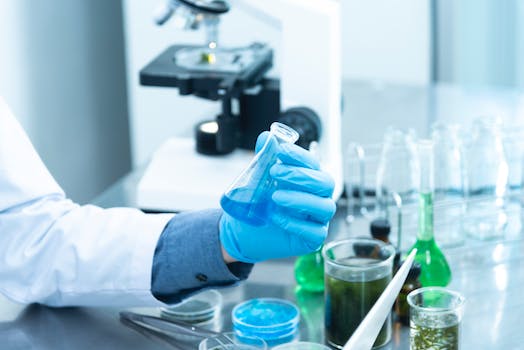

-
Table of Contents
"Guiding you through the microscopic world of bacteria."
Introduction
The Bacterial Navigator is a concept that refers to the ability of certain bacteria to navigate and move in response to various environmental cues. These cues can include chemical gradients, light, temperature, and mechanical forces. The ability of bacteria to navigate allows them to find optimal conditions for growth and survival, locate nutrients, avoid harmful substances, and interact with other organisms. Understanding the mechanisms behind bacterial navigation can provide valuable insights into their behavior and potentially lead to the development of new strategies for controlling bacterial infections or harnessing their capabilities for various applications.
The Importance of Bacterial Navigation in Microbial Ecology
The world of microbial ecology is a fascinating one, filled with countless microorganisms that play crucial roles in various ecosystems. Among these microorganisms, bacteria are particularly noteworthy for their ability to navigate their surroundings. Bacterial navigation is a complex process that allows these tiny organisms to move towards favorable environments and avoid harmful ones. This ability is of utmost importance in microbial ecology, as it enables bacteria to survive and thrive in diverse habitats.
One of the key reasons why bacterial navigation is so important in microbial ecology is its role in nutrient acquisition. Bacteria need to locate and access sources of nutrients in order to survive and reproduce. By navigating their surroundings, bacteria can actively seek out nutrient-rich areas and move towards them. This allows them to maximize their chances of obtaining the necessary resources for growth and survival. In this way, bacterial navigation contributes to the overall functioning and productivity of ecosystems.
Furthermore, bacterial navigation also plays a crucial role in the dispersal of bacteria. Microbial communities are often composed of diverse species that interact with each other and their environment. Bacterial navigation allows individual bacteria to move away from crowded areas and disperse to new locations. This dispersal is essential for maintaining genetic diversity within microbial communities and preventing the dominance of a single species. By navigating their surroundings, bacteria can find new habitats and colonize them, contributing to the overall resilience and stability of microbial ecosystems.
The ability of bacteria to navigate their surroundings is made possible by a variety of mechanisms. One such mechanism is chemotaxis, which involves the detection and response to chemical gradients in the environment. Bacteria can sense the concentration of certain chemicals and move towards or away from them accordingly. This allows them to locate favorable environments, such as areas with high nutrient concentrations, and avoid harmful ones, such as areas with toxic substances. Chemotaxis is a highly sophisticated process that involves intricate signaling pathways and molecular machinery within bacterial cells.
Another mechanism of bacterial navigation is phototaxis, which involves the detection and response to light. Some bacteria are capable of sensing light and using it as a cue to orient themselves in their environment. This is particularly important for bacteria that live in aquatic environments, where light is a crucial factor in determining their position and movement. By responding to light, bacteria can move towards areas with optimal light conditions for photosynthesis or away from areas with excessive light intensity that could damage their cellular machinery.
In addition to chemotaxis and phototaxis, bacteria can also navigate their surroundings through other mechanisms such as magnetotaxis, thermotaxis, and aerotaxis. These mechanisms involve the detection and response to magnetic fields, temperature gradients, and oxygen concentrations, respectively. Each of these mechanisms allows bacteria to sense and respond to specific environmental cues, enabling them to navigate their surroundings and find suitable habitats.
In conclusion, bacterial navigation is of utmost importance in microbial ecology. It allows bacteria to locate nutrient-rich areas, disperse to new habitats, and contribute to the overall functioning and stability of ecosystems. Through mechanisms such as chemotaxis, phototaxis, magnetotaxis, thermotaxis, and aerotaxis, bacteria can sense and respond to various environmental cues, guiding their movement and behavior. Understanding the intricacies of bacterial navigation is crucial for unraveling the complexities of microbial ecosystems and appreciating the vital role that bacteria play in shaping the world around us.
Understanding the Mechanisms Behind Bacterial Navigation

The ability of bacteria to navigate their environment is a fascinating phenomenon that has puzzled scientists for decades. How do these tiny organisms, with no eyes or ears, manage to find their way to food sources or avoid harmful substances? Understanding the mechanisms behind bacterial navigation is not only a matter of scientific curiosity but also has important implications for various fields, including medicine and environmental science.
One of the key mechanisms that bacteria use to navigate their surroundings is chemotaxis. Chemotaxis is the ability of bacteria to move towards or away from certain chemicals in their environment. This process is crucial for bacteria to find nutrients and avoid toxins. The way chemotaxis works is through a series of molecular sensors that detect changes in the concentration of specific chemicals. When the concentration of a particular chemical increases, the bacteria move towards it, and when it decreases, they move away.
The molecular sensors responsible for chemotaxis are called chemoreceptors. These receptors are located on the surface of the bacterial cell and are connected to a complex signaling pathway inside the cell. When a chemoreceptor detects a change in chemical concentration, it triggers a cascade of events that ultimately leads to changes in the movement of the bacteria. This movement is achieved through the rotation of tiny hair-like structures called flagella, which propel the bacteria forward or backward.
Another important mechanism that bacteria use for navigation is phototaxis. Phototaxis is the ability of bacteria to move towards or away from light. This behavior is observed in certain types of bacteria that live in aquatic environments, where light is an important source of energy. Similar to chemotaxis, phototaxis involves the use of molecular sensors that detect changes in light intensity. When the light intensity increases, the bacteria move towards it, and when it decreases, they move away.
The molecular sensors responsible for phototaxis are called photoreceptors. These receptors are sensitive to different wavelengths of light and can detect changes in intensity. When a photoreceptor detects a change in light intensity, it triggers a signaling pathway that leads to changes in the movement of the bacteria. In some cases, the movement is achieved through the rotation of flagella, similar to chemotaxis. In other cases, the bacteria change their shape or direction of movement in response to light.
Understanding the mechanisms behind bacterial navigation is not only fascinating from a scientific perspective but also has practical applications. For example, researchers are studying bacterial navigation to develop new strategies for controlling bacterial infections. By understanding how bacteria navigate their environment, scientists can potentially disrupt their ability to find host tissues or evade the immune system. This knowledge could lead to the development of new antibiotics or vaccines that target the navigation mechanisms of bacteria.
Furthermore, understanding bacterial navigation can also have implications for environmental science. Bacteria play a crucial role in various ecological processes, such as nutrient cycling and pollutant degradation. By understanding how bacteria navigate their environment, scientists can gain insights into how they interact with their surroundings and how they respond to environmental changes. This knowledge can help in the development of strategies for environmental remediation or the optimization of microbial processes in various industries.
In conclusion, the mechanisms behind bacterial navigation are complex and fascinating. Chemotaxis and phototaxis are two important mechanisms that bacteria use to navigate their environment. Understanding these mechanisms not only satisfies scientific curiosity but also has important implications for medicine and environmental science. By unraveling the secrets of bacterial navigation, scientists can potentially develop new strategies for controlling bacterial infections and optimizing microbial processes.
Applications of Bacterial Navigation in Biotechnology and Medicine
The ability of bacteria to navigate their environment has long fascinated scientists and researchers. These tiny organisms possess an impressive array of mechanisms that allow them to move towards or away from certain stimuli, such as light, chemicals, or temperature gradients. This unique ability has not only captured the attention of the scientific community but has also led to numerous applications in the fields of biotechnology and medicine.
One of the most promising applications of bacterial navigation lies in the field of bioremediation. Bacteria have the ability to sense and move towards pollutants in the environment, making them ideal candidates for cleaning up contaminated sites. By harnessing their navigation abilities, scientists can engineer bacteria to specifically target and degrade harmful substances, such as oil spills or toxic chemicals. This approach offers a more efficient and environmentally friendly alternative to traditional remediation methods, which often involve costly and time-consuming processes.
In addition to bioremediation, bacterial navigation has also found applications in the field of drug delivery. Traditional drug delivery systems often suffer from limitations such as poor targeting and low efficiency. However, by using bacteria as carriers, researchers can take advantage of their navigation abilities to deliver drugs directly to the site of infection or disease. This targeted approach not only increases the efficacy of the treatment but also reduces the potential side effects associated with systemic drug administration. Furthermore, bacteria can be engineered to release drugs in response to specific stimuli, such as pH or temperature changes, further enhancing their therapeutic potential.
Another area where bacterial navigation holds great promise is in the development of biosensors. Bacteria can be genetically modified to produce specific proteins or enzymes in response to certain stimuli. By incorporating these modified bacteria into biosensor devices, researchers can create highly sensitive and selective detection systems. For example, bacteria can be engineered to produce a fluorescent protein in the presence of a particular chemical or pathogen, allowing for rapid and accurate detection. This technology has the potential to revolutionize diagnostics, enabling early detection of diseases and improving patient outcomes.
Furthermore, bacterial navigation has also been utilized in the field of agriculture. By engineering bacteria to respond to specific plant signals, researchers can develop biofertilizers that enhance nutrient uptake and improve crop yields. These biofertilizers can be tailored to the specific needs of different crops, reducing the reliance on chemical fertilizers and minimizing environmental impact. Additionally, bacteria can be engineered to protect plants from pathogens or pests, offering a sustainable and eco-friendly alternative to traditional pesticides.
In conclusion, the ability of bacteria to navigate their environment has opened up a world of possibilities in the fields of biotechnology and medicine. From bioremediation to drug delivery, biosensors to agriculture, bacterial navigation has the potential to revolutionize various industries. By harnessing the natural abilities of these tiny organisms, scientists and researchers are paving the way for innovative and sustainable solutions to some of the world's most pressing challenges. As our understanding of bacterial navigation continues to grow, so too will the applications and benefits it brings to society.
Q&A
1. What is The Bacterial Navigator?
The Bacterial Navigator is a software tool used for analyzing and visualizing bacterial genomes.
2. What are the main features of The Bacterial Navigator?
The main features of The Bacterial Navigator include genome annotation, comparative genomics, phylogenetic analysis, and visualization of genomic data.
3. Who developed The Bacterial Navigator?
The Bacterial Navigator was developed by a team of researchers at the University of California, San Diego.
Conclusion
In conclusion, the bacterial navigator is a valuable tool that allows bacteria to sense and respond to their environment. It plays a crucial role in their survival and adaptation, enabling them to navigate towards favorable conditions and avoid harmful ones. The bacterial navigator's ability to detect and interpret various signals provides insights into bacterial behavior and opens up possibilities for applications in fields such as medicine and biotechnology. Further research in this area will continue to enhance our understanding of bacterial navigation and its implications.











